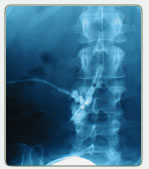 Spinal infusion therapy is carried out via a catheter placed within the spinal canal in the spinal fluid (intrathecal space), which serves to bathe the sensory nerves of the spinal cord with medication, in order to relieve pain and/or muscle spasms. The medication is contained within a pump, which is implanted between the skin and the muscle of the lower abdomen. This type of treatment is useful in cases where pain is not able to be controlled by medication administered by other routes (by mouth or by skin patch). The catheter consists of a small soft, flexible tube which is placed with a needle into the intrathecal space. The infusion pump is about 3-4 inches in diameter and about ¾ inch thick. A small pocket in the lower abdomen is created to contain the pump, and the pump is connected to the intrathecal catheter by another small flexible tube which is tunneled under the skin. The pump can be filled with a variety of medications, such as morphine, baclofen, hydromorphone, fentanyl, clonidine, local anesthetic, and ziconotide. Placement of the pump usually follows a successful trial of spinally-administered medication via an external pump, usually administered to the patient in the hospital.
Spinal infusion therapy is carried out via a catheter placed within the spinal canal in the spinal fluid (intrathecal space), which serves to bathe the sensory nerves of the spinal cord with medication, in order to relieve pain and/or muscle spasms. The medication is contained within a pump, which is implanted between the skin and the muscle of the lower abdomen. This type of treatment is useful in cases where pain is not able to be controlled by medication administered by other routes (by mouth or by skin patch). The catheter consists of a small soft, flexible tube which is placed with a needle into the intrathecal space. The infusion pump is about 3-4 inches in diameter and about ¾ inch thick. A small pocket in the lower abdomen is created to contain the pump, and the pump is connected to the intrathecal catheter by another small flexible tube which is tunneled under the skin. The pump can be filled with a variety of medications, such as morphine, baclofen, hydromorphone, fentanyl, clonidine, local anesthetic, and ziconotide. Placement of the pump usually follows a successful trial of spinally-administered medication via an external pump, usually administered to the patient in the hospital.
 The pump is available in two reservoir sizes. Determination of the proper size and type of pump depends on various factors: the patient’s size, and the type of medication, and the dose of medication used. Most pumps are able to contain two-to-three months’ of medication within the reservoir, and the pump is refilled in Dr. Chakerian’s office under local anesthesia. The pumps need to be replaced approximately every seven-to-nine years, although this depends on the brand and technology utilized.
The pump is available in two reservoir sizes. Determination of the proper size and type of pump depends on various factors: the patient’s size, and the type of medication, and the dose of medication used. Most pumps are able to contain two-to-three months’ of medication within the reservoir, and the pump is refilled in Dr. Chakerian’s office under local anesthesia. The pumps need to be replaced approximately every seven-to-nine years, although this depends on the brand and technology utilized.
Dr. Chakerian has been implanting and managing spinal pumps since 1993, and is one of the most experienced implanters in our area.

